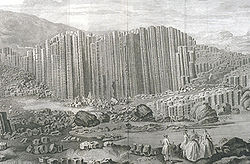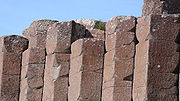
Giant's Causeway
Did you know...
SOS believes education gives a better chance in life to children in the developing world too. All children available for child sponsorship from SOS Children are looked after in a family home by the charity. Read more...
| Giant's Causeway and Causeway Coast | |
|---|---|
| Name as inscribed on the World Heritage List | |
 |
|
| Country | |
| Type | Natural |
| Criteria | VII, VIII |
| Reference | 369 |
| UNESCO region | Europe |
| Inscription history | |
| Inscription | 1986 (10th Session) |
The Giant's Causeway (or Irish: Clochán na bhFómharach) is an area of about 40,000 interlocking basalt columns, the result of an ancient volcanic eruption. It is located on the northeast coast of Northern Ireland, about two miles (3 km) north of the town of Bushmills. It was declared a World Heritage Site by UNESCO in 1986, and a National Nature Reserve in 1987 by the Department of the Environment for Northern Ireland. In a 2005 poll of Radio Times readers, the Giant's Causeway was named as the fourth greatest natural wonder in the United Kingdom. The tops of the columns form stepping stones that lead from the cliff foot and disappear under the sea. Most of the columns are hexagonal, although there are also some with four, five, seven and eight sides. The tallest are about 12 metres (36 ft) high, and the solidified lava in the cliffs is 28 metres thick in places.
The Giant's Causeway is today owned and managed by the National Trust and it is the most popular tourist attraction in Northern Ireland.
History
Geological
During the Paleogene period, Antrim was subject to intense volcanic activity, when highly fluid molten basalt intruded through chalk beds to form an extensive lava plateau. As the lava cooled rapidly, contraction occurred. While contraction in the vertical direction reduced the flow thickness (without fracturing), horizontal contraction could only be accommodated by cracking throughout the flow. The extensive fracture network produced the distinctive columns seen today. The basalts were originally part of a great volcanic plateau called the Thulean Plateau which formed during the Paleogene period.
Legend
Legend has it that the Irish giant Fionn mac Cumhaill (Finn McCool) built the causeway to walk to Scotland to fight his Scottish counterpart Benandonner. One version of the legend tells that Fionn fell asleep before he got to Scotland. When he did not arrive, the much larger Benandonner crossed the bridge looking for him. To protect Fionn, his wife Oonagh laid a blanket over him so he could pretend that he was actually their baby son. In a variation, Fionn fled after seeing Benandonner's great bulk, and asked his wife to disguise him as the baby. In both versions, when Benandonner saw the size of the 'infant', he assumed the alleged father, Fionn, must be gigantic indeed. Therefore, Benandonner fled home in terror, ripping up the Causeway in case he was followed by Fionn.
Another variation is that Oonagh painted a rock shaped like a steak and gave it to Benandonner, whilst giving the baby (Fionn) a normal steak. When Benandonner saw that the baby was able to eat it so easily, he ran away, tearing up the causeway.
The "causeway" legend corresponds with geological history in as much as there are similar basalt formations (a part of the same ancient lava flow) at the site of Fingal's Cave on the isle of Staffa in Scotland.
Tourism
The "discovery" of the Giant's Causeway was announced to the world in 1693 by the presentation of a paper to the Royal Society from Sir Richard Bulkeley, a fellow of Trinity College, Dublin, although the "discoverer" had, in fact, been the Bishop of Derry who had visited the site a year earlier. The site received international attention when Dublin artist Susanna Drury made watercolour paintings of it in 1739; they won Drury the first award presented by the Royal Dublin Society in 1740 and were engraved in 1743.In 1765 an entry on the Causeway appeared in volume 12 of the French Encyclopédie, which was informed by the engravings of Drury's work; the engraving of the "East Prospect" itself appeared in a 1768 volume of plates published for the Encyclopédie. In the caption to the plates French geologist Nicolas Desmarest suggested, for the first time in print, that such structures were volcanic in origin.
The site first became popular with tourists during the nineteenth century, particularly after the opening of the Giant's Causeway Tramway, and only after the National Trust took over its care in the 1960s were some of the vestiges of commercialism removed. Visitors can walk over the basalt columns which are at the edge of the sea, a half mile walk from the entrance to the site. The Causeway has been without a permanent visitors' centre since 2000, when the last building burned down. Public money was at that time set aside to construct a new centre and, following an architectural competition, a proposal was accepted to build a visitors' centre largely set into the ground, thus protecting the landscape surrounding the Causeway.
The 2007-2008 Controversy
In September 2007, however, a privately financed proposal for a new centre was given preliminary approval by the new Northern Ireland Environment Minister and Democratic Unionist Party (DUP) member Arlene Foster. Immediately afterwards, the public money that had been allocated to the Causeway development was frozen. The proposal resulted in a very public row about the relationship between the private developer Seymour Sweeney and the DUP; Mr Sweeney is a member of the DUP, although both parties deny that Mr Sweeney has ever given to the party financially.
There was also a good deal of disagreement as to whether a private developer should ever on principle be permitted to benefit from such a site as the Causeway, given both its cultural and economic importance and also in light of the fact that the site and its environs are largely owned by the National Trust. The Causeway is within Moyle District Council area, and the Council signalled its displeasure at the prospect of a private development; neighbouring Coleraine Borough Council also voted against the private plans and in favour of a public development project. Moyle Council responded to overtures by Mr Sweeney in November 2007 by handing the land on which the previous visitors' centre stood to the National Trust, thus giving the Trust complete control of both the Causeway and surrounding land.
On January 29, 2008, Minister Foster announced that she had now decided against Mr Sweeney's proposal for a new visitors' centre. Although the public funds for a Causeway scheme remain frozen for the moment, it seems highly likely that the publicly funded plan for the Causeway will now go ahead after all.
Similar structures
Although the basaltic columns of the Giant's Causeway are impressive, they are not unique. Basalt columns are a common volcanic feature, and they occur on many scales (faster cooling produces smaller columns). Other notable sites include Fingal's Cave in Scotland, Jusangjeolli on Jeju Island, South Korea, the Garni gorge in Armenia, the Cyclopean Isles near Sicily, Devils Postpile National Monument in California, The Cove Palisades State Park in eastern Oregon, Devils Tower National Monument in Wyoming, Santa Maria Regla Basalt Prisms in Hidalgo, Mexico, the "Organ Pipes" formation on Mount Cargill in New Zealand, Chongsokjong in North Korea, the giant "Rocha dos Bordões" ("Rod Rock") formation in Flores (Azores), at Gành Đá Đĩa in the Phú Yên province of Vietnam. and the "Columnar Cape" (Russian: Mis Stolbchaty) on Kunashir, the southernmost of the Kurile Islands in Russia.
Notable features, flora and fauna
Some of the structures in the area, having been subject to several million years of weathering, resemble objects, such as the Organ and Giant's Boot structures pictured here. Other features include many reddish, weathered low columns known as Giants Eyes, created by the displacement of basalt boulders; the Shepherd's Steps; the Honeycomb; the Giant's Harp; the Chimney Stacks; the Giant's Gate and the Camel's Hump. The area is a haven for sea birds such as fulmar, petrel, cormorant, shag, redshank guillemot and razorbill, while the weathered rock formations host a number of rare and unusual plants including sea spleenwort, hare's foot trefoil, vernal squill, sea fescue and frog orchid.
-
Giants Causeway Organ.jpg
The "pipe organ".
Appearances in popular culture
- The Causeway is the inspiration for the design of the logos for the various government departments of the Northern Ireland Executive. The colour of the rightmost column tops varies according to which department the logo represents.
- The Causeway appears on the cover of the Led Zeppelin album Houses of the Holy designed by Hipgnosis. Its surrounding waters formed the background for the cover of The Stone Roses (as part of John Squire's painting 'Bye Bye Badman').
- German dance group Scooter released a B-Side entitled "Giant's Causeway" on the 2003 single "Maria (I Like It Loud).
- On film it was used as a backdrop by Marillion for their video "Easter", and by Dave Finlay in a filmed vignette shown ahead of his WWE debut. It also features in the third film of Matthew Barney's The Cremaster Cycle, and in a regionally aired BBC Two Northern Ireland station ident.
- H.P. Lovecraft referred to the Causeway in his story of Antarctic horror, At the Mountains of Madness.
- Giants Causeway was a profilically winning racehorse trained by Aidan O'Brien. Victories included the 2000 Guineas, St James Palace Stakes and Sussex Stakes.
- In the computer game Myst III: Exile, the world of Amateria bears a strong resemblance to the Causeway, with a series of bridges and huts set atop an almost identical geological formation, also by the sea (although in the game an ocean surrounds it completely).









